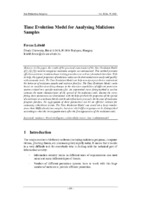Time Evolution Model for Analysing Malicious Samples

View/
Metadata
Show full item record
URI
Collections
Abstract
In this paper, the results of the practical examination of the Time Evolution Model
([1] [2] [3]) used to categorize malicious samples are summarized. This method provides
effective assistance in anti-malware testing procedures as well as cyberattack detection. With
its help, the typical properties of malicious codes can be determined more easily and quickly
with automatic tools. The Time Evolution Model can help security experts better understand
the behavior of malicious attacks and malware families. The Time Evolution Model works
based on variables describing changes in the detection capabilities of different protection
systems related to a specific malicious file. An exponential curve fitting method is used to
estimate the main characteristics of the spread of the malicious code. During the curve
fitting, three parameters are determined, with the help of which the properties of the spread
of a malware or a malware family can be identified more precisely. In the case of malicious
program families, the aggregation of these parameters can be an effective solution for
estimating cyberthreat trends. The Time Evolution Model was tested on a large number
(more than 1000) of malicious samples, based on which different groups can be distinguished
according to when the investigation starts after the first appearance of the malicious code.
- Title
- Time Evolution Model for Analysing Malicious Samples
- Author
- Leitold, Ferenc
- xmlui.dri2xhtml.METS-1.0.item-date-issued
- 2024
- xmlui.dri2xhtml.METS-1.0.item-rights-access
- Open access
- xmlui.dri2xhtml.METS-1.0.item-identifier-issn
- 1785-8860
- xmlui.dri2xhtml.METS-1.0.item-language
- en
- xmlui.dri2xhtml.METS-1.0.item-format-page
- 14 p.
- xmlui.dri2xhtml.METS-1.0.item-subject-oszkar
- malware, threat intelligence, vulnerability metric, time evolution model
- xmlui.dri2xhtml.METS-1.0.item-description-version
- Kiadói változat
- xmlui.dri2xhtml.METS-1.0.item-identifiers
- DOI: 10.12700/APH.21.11.2024.11.14
- xmlui.dri2xhtml.METS-1.0.item-other-containerTitle
- Acta Polytechnica Hungarica
- xmlui.dri2xhtml.METS-1.0.item-other-containerPeriodicalYear
- 2024
- xmlui.dri2xhtml.METS-1.0.item-other-containerPeriodicalVolume
- 21. évf.
- xmlui.dri2xhtml.METS-1.0.item-other-containerPeriodicalNumber
- 11. sz.
- xmlui.dri2xhtml.METS-1.0.item-type-type
- Tudományos cikk
- xmlui.dri2xhtml.METS-1.0.item-subject-area
- Természettudományok - multidiszciplináris természettudományok
- xmlui.dri2xhtml.METS-1.0.item-publisher-university
- Óbudai Egyetem
